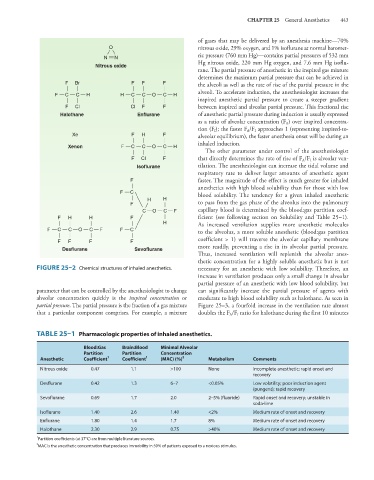Page 457 - Basic _ Clinical Pharmacology ( PDFDrive )
P. 457
CHAPTER 25 General Anesthetics 443
of gases that may be delivered by an anesthesia machine—70%
O nitrous oxide, 29% oxygen, and 1% isoflurane at normal baromet-
ric pressure (760 mm Hg)—contains partial pressures of 532 mm
N N
Nitrous oxide Hg nitrous oxide, 220 mm Hg oxygen, and 7.6 mm Hg isoflu-
rane. The partial pressure of anesthetic in the inspired gas mixture
determines the maximum partial pressure that can be achieved in
F Br F F F the alveoli as well as the rate of rise of the partial pressure in the
alveoli. To accelerate induction, the anesthesiologist increases the
F C C H H C C O C H
inspired anesthetic partial pressure to create a steeper gradient
F Cl Cl F F between inspired and alveolar partial pressure. This fractional rise
Halothane Enflurane of anesthetic partial pressure during induction is usually expressed
as a ratio of alveolar concentration (F ) over inspired concentra-
A
tion (F ); the faster F /F approaches 1 (representing inspired-to-
I
I
A
Xe F H F alveolar equilibrium), the faster anesthesia onset will be during an
inhaled induction.
Xenon F C C O C H
The other parameter under control of the anesthesiologist
F Cl F that directly determines the rate of rise of F /F is alveolar ven-
A
I
Isoflurane tilation. The anesthesiologist can increase the tidal volume and
respiratory rate to deliver larger amounts of anesthetic agent
F faster. The magnitude of the effect is much greater for inhaled
anesthetics with high blood solubility than for those with low
F C blood solubility. The tendency for a given inhaled anesthetic
H H to pass from the gas phase of the alveolus into the pulmonary
F
C O C F capillary blood is determined by the blood:gas partition coef-
F H H F ficient (see following section on Solubility and Table 25–1).
H As increased ventilation supplies more anesthetic molecules
F C C O C F F C to the alveolus, a more soluble anesthetic (blood:gas partition
coefficient > 1) will traverse the alveolar capillary membrane
F F F F
Desflurane Sevoflurane more readily, preventing a rise in its alveolar partial pressure.
Thus, increased ventilation will replenish the alveolar anes-
thetic concentration for a highly soluble anesthetic but is not
FIGURE 25–2 Chemical structures of inhaled anesthetics. necessary for an anesthetic with low solubility. Therefore, an
increase in ventilation produces only a small change in alveolar
partial pressure of an anesthetic with low blood solubility, but
parameter that can be controlled by the anesthesiologist to change can significantly increase the partial pressure of agents with
alveolar concentration quickly is the inspired concentration or moderate to high blood solubility such as halothane. As seen in
partial pressure. The partial pressure is the fraction of a gas mixture Figure 25–3, a fourfold increase in the ventilation rate almost
that a particular component comprises. For example, a mixture doubles the F /F ratio for halothane during the first 10 minutes
I
A
TABLE 25–1 Pharmacologic properties of inhaled anesthetics.
Blood:Gas Brain:Blood Minimal Alveolar
Partition Partition Concentration
Anesthetic Coefficient 1 Coefficient 1 (MAC) (%) 2 Metabolism Comments
Nitrous oxide 0.47 1.1 >100 None Incomplete anesthetic; rapid onset and
recovery
Desflurane 0.42 1.3 6–7 <0.05% Low volatility; poor induction agent
(pungent); rapid recovery
Sevoflurane 0.69 1.7 2.0 2–5% (fluoride) Rapid onset and recovery; unstable in
soda-lime
Isoflurane 1.40 2.6 1.40 <2% Medium rate of onset and recovery
Enflurane 1.80 1.4 1.7 8% Medium rate of onset and recovery
Halothane 2.30 2.9 0.75 >40% Medium rate of onset and recovery
1
Partition coefficients (at 37°C) are from multiple literature sources.
2
MAC is the anesthetic concentration that produces immobility in 50% of patients exposed to a noxious stimulus.

